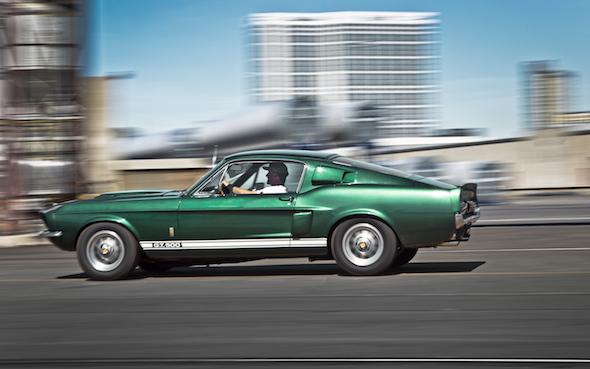The Ford Mustang turns fifty soon, and in celebration, we look back at the history of a car that has set the standard for American automobiles through five vastly different decades of motoring, and in the process become an American legend.
On April 17th, 1964, the course of American automotive history was changed forever. Back then the “World’s Fair” was a major place to debut new cars, and with the fair in New York, the Big Three (Ford, GM, Chrysler) jumped at the chance to unveil all their new models in front with the whole world watching. Many cars saw the light of day for the first time that April, yet only one stick in the American consciousness. It was the brainchild of an ambitious Ford executive named Lee Iacocca, aimed at shedding the Ford image of drab, safe, and slow. He called it the Mustang.
Over 600,000 1965 model ‘Stangs were sold in the coming year. It was small, sleek, sexy, and powerful, and the American people jumped for it. In addition to being a sales hit, racing legend Carroll Shelby took a base fastback model, the same one roaming the streets of America with teens, housewife’s, and businessmen at the wheel, and turned it into the GT350, a fire breathing race car that beat all comers in every American sports car championship for the next several years, and started the great pony car rage.
The late 60’s were the golden age of the muscle car, a romanticized era of thundering V8’s, drag races at the lights, and speed heroes. And the muscle car that inspired the greatest legends was the Mustang. Boss 429’s, Cobra Jets, Mach 1’s, King of the Road’s, all famed Mustangs still referred to with awe in garages across America. And yet beyond the technical aspects, the horsepower ratings, quarter mile times, the Mustang came as a sort of great social equalizer. The common man’s racer. A whole generation who could dream of affording a Porsche of Ferrari could now beat those very cars….in a Ford. Popular culture became infused with them, most notably the iconic green ’68 GT that Steve McQueen raced through the streets of San Francisco in the legendary film Bullitt. And so the Mustang entered the great collective conscience of the nation, resonating with people who knew nothing about engines, transmissions, or suspension, as a symbol of speed, daring, and adventure. There were other muscle cars of the 60’s, other legendary racing machines, but basis, and the standard, of the whole era was the Mustang.
But the times were changing, as they are prone to do, and by the early 70’s, the muscle car was out of fashion. Apparently big V8’s hurt the environment, which the government felt obliged to do something about, and the U.S. Government helped the Israelis win a war, which the Middle Eastern petroleum companies felt obliged to do something about. The result was weaker, more environmentally friendly engines, and a huge decrease in demand for engines with bad gas mileage. The Mustang followed suit, becoming smaller, more fuel efficient, and dramatically less powerful. The new generation was called the Mustang II, and it is known as the bastard child of the Mustang legacy. Ugly, with no performance, and prone to breaking down, history does not look fondly on the Mustang II. And yet, it was the perfect car for its time. It sold extremely well, was very popular, and got good gas mileage. The 70’s was the beginning of the American automobiles descent down the slippery slope of mediocrity, a trend that they are still trying to recover from, but the Mustang II, as abominable as it may be to enthusiasts, was the perfect car for the time. It sold extremely well, was popular in its day, and set the standard in Detroit for the dying days of the Motor City’s dominance.
The 80’s brought along more change, both in the motor industry and the country itself, and with it came the next generation Mustang, the “Fox-Body” (named for the “Fox” chassis it rode on). The 80’s were the yuppie generation, influenced by a booming economy and the Reagan revolution, and interested in cars that were cool, stylish, and fashionable, regulating performance to an all-time low. The Mustang followed the trend, and in the early 80’s lost any power that was left, regulating the once mighty pony car to a hatchback favored by young, upper middle class yuppies. There was barely any semblance of the Mustangs original DNA left, but once again, it was the perfect car for its time. America wanted hatchbacks, so Ford gave them a hatchback, and a wildly popular one at that.
But America kept changing, and by the early 90’s, performance was in demand again. Ford answered with the fourth generation Mustang, led by a model called the SVT Cobra. The Cobra was a return to the high performance roots of the 60’s, even using the same famed 302 cubic inch V8 seen on the legendary Boss models. And the Cobra used it to become a legend in its own right, beating Corvettes, Porsches, and virtually any other car that dared challenge it. The cutting edge of American automotive technology yet again featured the galloping pony logo on its front grill.
The most current Mustang, the once we see most often prowling the streets, was introduced in 2005. With a retro body heavily inspired by its 60’s ancestors, and more than enough performance to justify it, the newest Mustang became wildly popular. Just as it had forty years previous, the ‘Stang sparked a whole new class of American automobile, a modern muscle car, based off of the cars of the 60’s, but with modern luxuries, updated looks, and even more power. The new Camaro and Challenger, among others, are a direct result, and they have become among the most popular cars in America.
And so yesterday, the newest Mustang was introduced. It’s smaller, sleeker, and far less retro inspired than its predecessor. Ford wants more customers in Europe, and so its famed muscle car has undergone a redo to satisfy consumers overseas, and to get rid of Ford’s label of slow and boring over there. Sounds exactly what Lee Iacocca tried to do fifty years ago in U.S. And boy, did he succeed.


